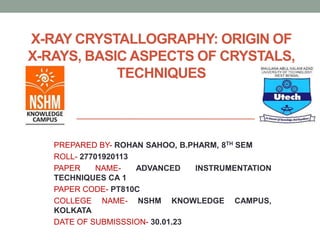
X-Ray Crystallography.pptx
- 1. X-RAY CRYSTALLOGRAPHY: ORIGIN OF X-RAYS, BASIC ASPECTS OF CRYSTALS, TECHNIQUES PREPARED BY- ROHAN SAHOO, B.PHARM, 8TH SEM ROLL- 27701920113 PAPER NAME- ADVANCED INSTRUMENTATION TECHNIQUES CA 1 PAPER CODE- PT810C COLLEGE NAME- NSHM KNOWLEDGE CAMPUS, KOLKATA DATE OF SUBMISSSION- 30.01.23
- 2. What are X-rays? • X-Rays(Roentgen rays) were discovered by Roentgen in 1895. X rays are invisible, highly penetrating electromagnetic radiation of much shorter wavelength(higher frequency) than visible light. The wavelength range for X rays is from about 10-8m to about 10-11m(0.1 to 100Å). The discovery of X rays gave crystallographers a powerful tool that could “see inside” of crystals and allow for detailed determination of crystal structure and unit cell size.
- 3. Origin of X-Rays: X-rays are generated when high velocity electrons impinge on a metal target. The electrons are arranged in layers or shells(K,L,M..) with the valence electron in outer shell. Whenever fast moving electron impinges onto an atom, it may knock out an electron from inner shell of that atom. Following the loss of electron one of outer electrons will fall into the vacated orbital, with simultaneous emission of X-ray photon. The energy of the emitted X-ray photon is equal to the difference in energy between the two levels involved.
- 4. X-Ray generation: • A. Target molecule(anode) • B. Ua and Uh are battery to emit thermoionic electrons • C. Cathode-filament of tungsten metal
- 5. Basic Aspects Of Crystals: A crystal is any solid material in which, the components atoms are arranged in a definite pattern. Crystallography is the experimental science of the arrangements of atom in solid. The word “crystallography” derived from the Greek word “crystallon” means cold drop/frozen drop and “grapho” means write. Crystal structure= Lattice + Basis Lattice: “An infinite periodic array of points in a space. The arrangements of points defines the lattice symmetry. A lattice may be one, two or three dimensional. Basis: A group of one or more atoms, located in a particular way with respect to each other and associated with each point is known as Basis. So we obtain a crystal structure by adding the lattice and basis, we can say that, when an atom or identical group of atom is attached to every lattice point, we obtain a crystal structure.
- 6. Continued.. The atoms are arranged in a regular pattern and there is an smallest volume element that by repetition in three dimensions describe the crystal. This smallest volume element is called unit cell. The dimensions of the unit cell is described by three axes: a, b, c and the angles between them α,β and γ are the lattice constants which can be determined by XRD.
- 7. X-Ray Diffraction Techniques: When a beam of x-radiation is incident upon a substance, the electrons constituting the atoms of the substance emit electromagnetic radiations in all the directions at the same frequency as that of incident X-radiation. XRD methods are generally used for investigating the internal structures and crystal structures of various solid compounds. They are: I. Laue method II. Rotating crystal method III. Powder diffraction
- 8. Laue Method o The Laue method is mainly used to determine the orientation of large single crystals while radiation is reflected from, or transmitted through a fixed crystal. o The diffracted beams forms arrays of spots, that lie on curves on the film. o The Bragg angle is fixed for every set of planes in the crystals. Each set of planes picks out & diffracts the particular wavelength from the white radiation that satisfies the Bragg law for the value of d & θ involved.
- 9. Rotating Crystal Method In this method, a single crystal is rotated about the fixed axis in a beam of monochromatic. The angle θ is variable while, the wavelength is kept constant. A cylindrical film is placed around it and the crystal is rotated about the chosen axis. As a crystal rotates, sets of lattice will at some point make the correct Bragg angle for the monochromatic beam, and that point a diffracted beam will be formed. Lattice constant of the crystal can be determined by this method, for a given wavelength if the angle at which are reflection occurs is known, can be determined. The reflected beam are located on the surface of imaginary cones. By recording the diffraction patterns, one can determine the shape and size of unit cell as well as arrangement of atom inside the cell.
- 10. Powder Diffraction Method o If a powdered specimen is used, instead of a single crystal, then there is the specimen, because there will always be some crystals at an orientation for which diffraction is permitted. Here a monochromatic X-ray beam is incident on a powdered sample. o This method is useful for samples that are difficult to obtaining single crystal form. o For every set of crystal planes, by chance, one or more crystals will be in the correct orientation to give correct Bragg angle to satisfy Bragg’s equation. Each diffraction line is made up of a large number of small spots, each from a separate crystal. Each spot is so small as to give the appearance of a continuous line. o This method is known to be the most fast and accurate for the determination of lattice constant.
- 11. THANK YOU